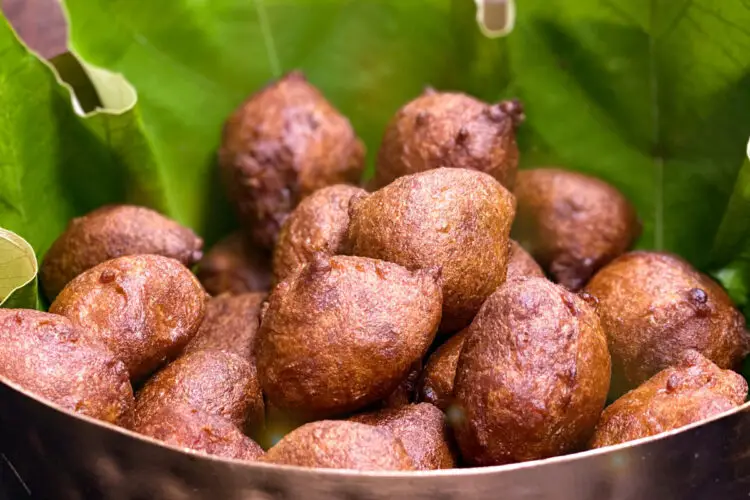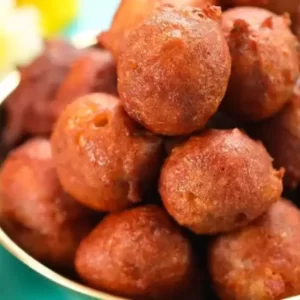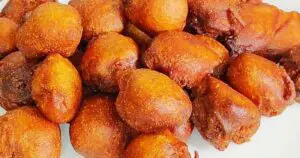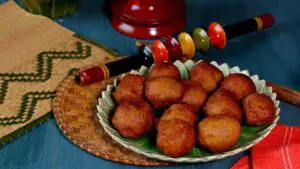Gulgule, also known as Gur ke Gulgule, is a popular North Indian sweet dish made with jaggery (gur) and flour. It is often prepared during festivals or special occasions. Gulgules are small, deep-fried dumplings that have a crispy exterior and a soft, spongy interior. The addition of jaggery gives them a rich, caramel-like sweetness. Here’s a simple recipe for making Gulgulas with jaggery:
Also, read more sweet recipes:
Ingredients:
- 1 cup all-purpose flour (maida)
- 1/2 cup jaggery (grated or powdered)
- 1/4 cup semolina (sooji/rava)
- 1/2 teaspoon fennel seeds (Saunf)
- 1/2 teaspoon cardamom powder
- A pinch of baking soda
- Oil for deep frying
- Water (as needed)
Instructions:
- In a mixing bowl, add all-purpose flour, semolina, grated jaggery, fennel seeds, cardamom powder, and a pinch of baking soda. Mix them well.
- Gradually add water to the mixture and whisk it to form a smooth batter. The consistency should be thick enough to coat the back of a spoon.
- Allow the batter to rest for about 15-20 minutes. This will help the flavors to meld together.
- Heat oil in a deep pan or kadai over medium heat.
- Once the oil is hot, reduce the flame to low. Take small portions of the batter with your fingers or a spoon and drop them gently into the oil. You can make small round dumplings or irregular shapes, as per your preference.
- Fry the Gulgulas on low heat until they turn golden brown and crisp from all sides. Make sure to fry them in batches, so they don’t stick together.
- Using a slotted spoon, remove the fried Gulgulas from the oil and drain them on a paper towel to remove excess oil.
- Repeat the process with the remaining batter until all the Gulgulas are fried.
- Serve the Gulgulas warm as a sweet snack or dessert. They can be enjoyed on their own or paired with a cup of tea or coffee.
Gulgules with jaggery is a delightful treat that is loved by both kids and adults. They offer a wonderful combination of sweetness and crunchiness, making them a perfect indulgence for special occasions or whenever you crave something sweet. Enjoy!
about:
Jaggery, also known as “gur” in Hindi, is a natural sweetener that is made from the juice of sugarcane or palm trees. It is unrefined and retains more nutrients compared to refined sugar. Jaggery has a distinct caramel-like flavor and adds a rich sweetness to dishes.
To make Gulgules with jaggery, the jaggery is grated or powdered and combined with flour, semolina, fennel seeds, cardamom powder, and a pinch of baking soda. Water is added to form a thick batter, which is then allowed to rest for a while to enhance the flavors.
The batter is then deep-fried in hot oil until the Gulgules turn golden brown and crisp. The frying process gives them a crispy exterior while keeping the inside soft and spongy. Once fried, they are drained on a paper towel to remove excess oil.
Gulgules with jaggery are usually served warm and can be enjoyed as a sweet snack or desser
t. They have a delightful combination of flavors, with the sweetness of jaggery and the aromatic hints of fennel seeds and cardamom. They are often enjoyed during festivals like Diwali or Holi, or as a special treat on occasions and celebrations.
These sweet dumplings are loved for their unique taste and texture and are a popular choice for those with a sweet tooth. They are best enjoyed fresh and can be served on their own or paired with a cup of tea, coffee, or milk.
I hope this provides a more detailed understanding of Gulgule with jaggery. If you have any more specific questions, feel free to ask!
Serving Suggestions:
- Serve the warm Gulgule on their own without any accompaniments. They make a delicious sweet snack or dessert.
- Drizzle some warm jaggery syrup or honey over the Gulgulas for an extra touch of sweetness and moisture.
- Dust the Gulgules with powdered sugar just before serving. This adds a beautiful snowy appearance and a touch of sweetness.
- Serve the Gulgules with a side of warm cardamom-flavored milk.
- Serve the Gulgules with a side of Rabri or sweetened condensed milk. The creamy and rich textures of these accompaniments complement the crispy Gulgulas.
- Serve the Gulgules with a side of sliced fresh fruits such as bananas, mangoes, or strawberries.
- For a decadent twist, serve the Gulgulas with a scoop of your favorite ice cream. The warm Gulgulas and cold ice cream make a delightful combination of temperatures and textures.
Tips:
- The sweetness of Gulgulas can be adjusted by adding more or less jaggery according to your taste preference.
- The batter should have a thick pouring consistency, similar to pancake batter. If it is too thick, you can add a little more water to achieve the desired consistency. If it is too thin, add a little more flour to thicken it.
- Allowing the batter to rest for about 15-20 minutes helps the flavors to develop and results in a better texture of the Gulgulas.
- Maintain the oil temperature at medium heat while frying the Gulgulas. This ensures they cook evenly and don’t become too dark on the outside while remaining uncooked on the inside.
Variations:
- Nuts and Dry Fruits: Add chopped nuts like almonds, cashews, or pistachios, as well as dry fruits like raisins or chopped dates, to the batter for added texture and flavor.
- Coconut: You can add grated or desiccated coconut to the batter to give the Gulgulas a subtle coconut flavor.
- Spices: Experiment with spices like cinnamon, nutmeg, or ginger powder to enhance the flavor profile of the Gulgulas.
- Gluten-free: Substitute all-purpose flour with gluten-free flour blends like rice flour or chickpea flour for a gluten-free version of Gulgulas.
- Baking: If you prefer a healthier alternative to deep-frying, you can try baking the Gulgulas in a preheated oven at 350°F (175°C) until they are golden brown and cooked through.
- Jaggery Syrup: Instead of adding jaggery directly to the batter, make jaggery syrup by dissolving jaggery in water and simmering it until it thickens. Pour this syrup over the fried Gulgulas before serving.
FAQs
Q: Can I use whole wheat flour instead of all-purpose flour?
A: Yes, you can substitute all-purpose flour with whole wheat flour for a healthier version of Gulgule. Keep in mind that whole wheat flour tends to make the Gulgulas denser and may require slightly more water to achieve the right consistency.
Q: Can I make the batter in advance?
A: It is generally recommended to make the batter fresh and fry the Gulgulas immediately for the best texture
and flavor. If you need to prepare the batter in advance, you can refrigerate it for a few hours and allow it to come to room temperature before frying.
Q: How should I store leftover Gulgule?
A: Leftover Gulgule can be stored in an airtight container at room temperature for 1-2 days. If you plan to store them for longer, it’s best to refrigerate them. Reheat them in a preheated oven or microwave before serving.
Q: Can I use other sweeteners instead of jaggery?
A: Yes, if jaggery is not readily available, you can use alternatives like brown sugar, palm sugar, or maple syrup. However, keep in mind that the flavor and sweetness may differ slightly from using jaggery.
Q: Can I make Gulgule without deep frying?
A: While deep frying is the traditional method for making Gulgule, you can try baking them in the oven for a healthier option. Preheat the oven to 350°F (175°C) and place the Gulgulas on a greased baking sheet. Bake for about 15-20 minutes or until they turn golden brown, flipping them halfway through.
Q: Can I freeze gulgule?
A: It is not recommended to freeze the batter or the fried Gulgule, as they may lose their texture and become soggy when thawed. It’s best to consume them fresh or store them at room temperature for a short period.
Conclusion
In conclusion, Gulgule are a delightful Indian sweet treat that can be prepared effortlessly in the comfort of your kitchen. These golden-brown fritters, with their crispy exterior and soft interior, are sure to please your taste buds. Whether it’s a festive occasion or a simple craving for something sweet, Gulgule make for the perfect choice.
Nutrition
The nutritional value of Gulgule with jaggery can vary dependin
g on the specific ingredients used and the portion size. Here is a general overview of the approximate nutritional information for Gulgulas made with all-purpose flour and jaggery:
Please note that these values are approximate and can vary based on the specific recipe and preparation method:
- Serving Size: 1 Gulgula (approximately 25-30 grams)
- Calories: Around 80-100 calories per gulgula
- Carbohydrates: Approximately 15-20 grams per gulgula
- Protein: Around 1-2 grams per gulgula
- Fat: Approximately 2-4 grams per gulgula
- Fiber: Minimal fiber content
- Sodium: Negligible amounts
- Iron: Small amounts from the flour and jaggery
- Calcium: Minimal amounts
Gulgule Recipe | HOW TO MAKE GULGULA | SWEET PUA
Gulgule, also known as Gur ke Gulgule, is a popular North Indian sweet dish made with jaggery (gur) and flour. It is often prepared during festivals or special occasions.
Ingredients
- 1 cup all-purpose flour (maida)
- 1/2 cup jaggery (grated or powdered)
- 1/4 cup semolina (sooji/rava)
- 1/2 teaspoon fennel seeds (Saunf)
- 1/2 teaspoon cardamom powder
- A pinch of baking soda
- Oil for deep frying
- Water (as needed)
Instructions
- In a mixing bowl, add all-purpose flour, semolina, grated jaggery, fennel seeds, cardamom powder, and a pinch of baking soda. Mix them well.
- Gradually add water to the mixture and whisk it to form a smooth batter. The consistency should be thick enough to coat the back of a spoon.
- Allow the batter to rest for about 15-20 minutes. This will help the flavors to meld together.
- Heat oil in a deep pan or kadai over medium heat.
- Once the oil is hot, reduce the flame to low. Take small portions of the batter with your fingers or a spoon and drop them gently into the oil. You can make small round dumplings or irregular shapes, as per your preference.
- Fry the Gulgulas on low heat until they turn golden brown and crisp from all sides. Make sure to fry them in batches, so they don't stick together.
- Using a slotted spoon, remove the fried Gulgulas from the oil and drain them on a paper towel to remove excess oil.
- Repeat the process with the remaining batter until all the Gulgulas are fried.
- Serve the Gulgulas warm as a sweet snack or dessert. They can be enjoyed on their own or paired with a cup of tea or coffee.





